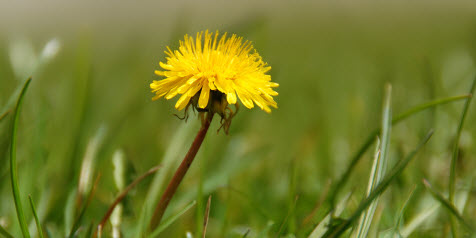Beautiful in their own right and useful, too, the hardy dandelion is a nuisance in the lawn and garden and can turn ugly overnight as it closes at sundown and is not pretty in a group once they’ve gone to seed.
But how can we cope with these successful survivors in a world gone soft on chemical weed retardants?
There are a few strategies:
Strategy No. 1
First, there is always good old elbow grease. Get out there and dig, but do this early and often as it is easier to get the full root in springtime when the ground is still soft and friable. Even then, chances are good that you will be leaving behind enough root to allow regeneration, so you may want to follow up with additional action.
Strategy No. 2
Don’t let the flowers go to seed. This sounds easier than it is as dandelions are often lawn mower resistant. They tend to bend and avoid the blades of the mower. Moreover, if you cut them often enough, they learn not to send up tall stalks on their flowers, often hugging the ground below lawn mower blade height. If this happens, return to strategy No. 1.
Strategy No. 3
Use a seed suppressant such as corn gluten meal. This common byproduct of corn meal inhibits germination of seeds. This helps to control airborne propagation from the neighbour’s weed patch.
Strategy No. 4
Keep your lawn thick and healthy so that dandelions can’t get a foothold. Water at least an inch once a week (twice a week in very hot, dry weather).
Fertilize in springtime or late fall after the first frost. Dethatch or aerate once every few years.
Strategy No. 5
As a last resort, there are still a few broadleaf weed killers on the market that you can use to treat your lawn to get rid of the worst infestations.
Strategy No. 6
Harvest the little devils and eat them.
Leaves: Rich in potassium and anti-oxidants as well as vitamins A and C, they can be eaten raw in salads, or sautéed, boiled, steamed or braised. Harvest the leaves before the first flower emerges for eating raw. The leaves are somewhat bitter.
Roots: High inulin and levulin, two starches that help balance blood sugar, roots can be eaten raw, steamed or roasted like parsnips. They can also be dried, roasted and ground for a coffee substitute. Roots also aid in digestion.
Flowers: Best known for their role in making dandelion wine, the flowers can also be dipped in batter and deep fried as fritters.



